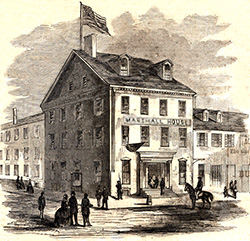
Please send all Checks and Money orders to :
Dave Taylor P.O. Box 87 Sylvania, OH 43560
419-842-1863
Click Here to E-mail Us!


13 08


13-08-01 … Extremely Rare Large Size 1860 Etched Blade Sheffield Bowie Knife
Having Barbers Patent Markings and Matching Scabbard: This is the first of these Bowies I have encountered and one I wager very few (if any) of you have seen previously including the advanced Bowie collectors. This one is ultra desirable with blade etching which reads X L N T BOWIE KNIFE and being housed in the original green leatherette sheath embossed with the same X L N T / Bowie Knife marking. The blade is also stamped at the ricasso H. Barbers Patent / Sheffield. The XLNT (excellent) marking is an oblique copy of the famous IXL ( I Excel) marking found on the products of George Wostenholm, also of Sheffield. We encounter very few Bowies which are actually marked with the wording Bowie Knife, making this a very scarce knife and one that is a TRUE BOWIE and not just a dirk or dagger that some collector is calling a Bowie. Mr. Barber was definitely cashing in on the fame of brothers Jim and Rezin Bowie with these blade and sheath markings. This knife is substantial. It measures just a hair under one foot in overall length. Condition is about fine. The handle is a very well crafted union of German silver and polished horn. The German Silver center spine on each side of the handle is a single substantial piece of solid metal which forms a very strong cross guard, center support bar, and pommel cap … all in one decorative piece which adds greatly to the durability and beauty of the handle and guard. Each side of the handle has this German silver center spine which is secured to the tang of the blade with finely finished bolsters, and is finished and fitted with polished horn slabs to form a truly handsome grip. The photos tell the story. An 1860 entry from the book The Journal of the Society of Arts, Institutions in Union finds the following data on H.Barber … Dated 27th December 1860 H. Barber 60 Thomas Street, Sheffield An Imp. In the manufacture of spring knife scales and knife handles. The previously described handle on this knife is obviously the element that pertains to the H. Barbers Patent marking on the ricasso. There are a couple minor worm holes in the horn otherwise fine. The sheath lacks the German silver tip and shows some scuffs. The throat is firmly in place. A truly rare and desirable Civil War Bowie Knife with ultra desirable markings
… I have never seen another
… $2,500.00
Click Here to E-mail Us!
Call us @ 419-842-1863
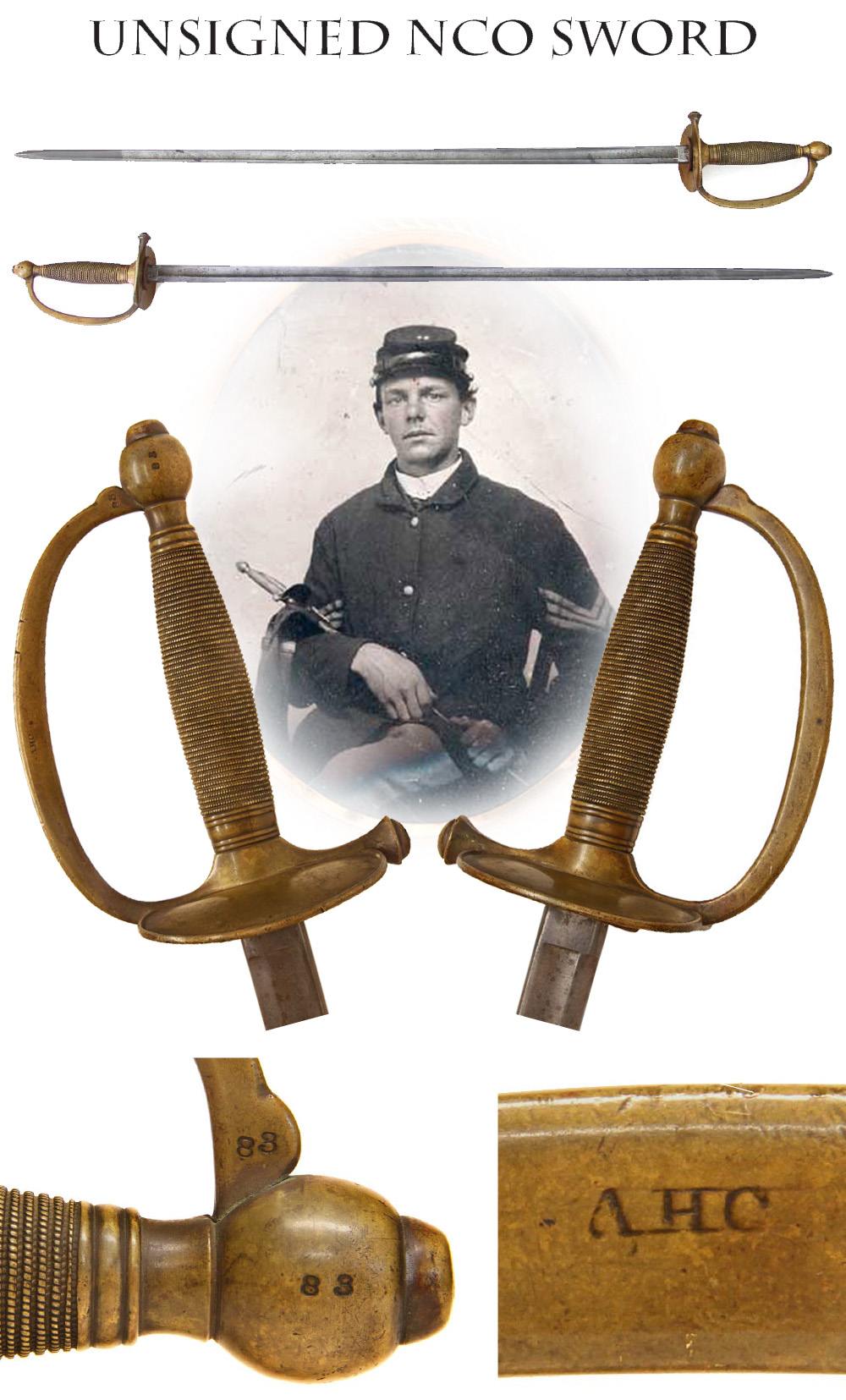
13-08-02 – 1840 Pattern NCO Sword:
These straight-bladed swords are typically termed the Non-commissioned Officer or NCO sword, but strictly speaking are only for the five sergeants in a Yankee infantry company: the First or Orderly Sergeant, and four others. Sergeants having a sword as one of their badges of rank was a tradition in the US army going back to the Revolution. This pattern replaced the short 1832 short sword that had been used by NCOs and remained in service as a short sword for foot or heavy artillery. They are a key piece in an American edged weapons collection. This is a regulation example, brass hilted, with knuckle guard and double clamshell counterguard very slightly downturned, brass ribbed grip and long, straight spadroon shaped blade with a single broad fuller. Brass shows a nice undisturbed aged patina. Blade is good with no nicks, a silver gray throughout, somewhat darker shade near the tip and a few dark spots here and there. No makers mark is visible on the ricasso, AHC inspectors stamp on the guard is vivid as is the matching rack number 83 on the guard and pommel. Not sure if the makers mark was omitted at the time of manufacture or removed a hundred years ago. Would look great on the wall and is about as inexpensive a genuine Civil War sword as you are ever going to find. Sword only (no scabbard)
$225.00
Click Here to E-mail Us!
Call us @ 419-842-1863

13-08-03 – Attractive 1849 Dated Ames Light Artillery Saber:
The Ames Company needs little introduction. It was one of the most prolific suppliers of edged weapons in the United States for much of the 19th century. This example of their work is another key weapon for a Civil War or American sword collection, the US 1840 pattern light artillery saber. Issued to horse artillerymen and drivers, who might be called upon to defend themselves while mounted, this is a nice example with original leather and wire on the grip and legible makers mark on the ricasso: AMES MFG. CO. / CABOTVILLE / 1849 on one side and US / WD on the other. Blade is very good with no pitting or rust. There are two tiny edge nicks. The blade color is a cloudy gray with some lighter areas showing through. The leather wrap and twisted wire are firmly in place. A very presentable sword in as found attic condition. Mellow aged patina on the brass guard and pommel. This is the early pattern saber with a recessed area on the underside of the guard to accept the early style lipless scabbard throat. I have this priced as friendly as I can make it
$395.00
Click Here to E-mail Us!
Call us @ 419-842-1863

13-08-04 – Civil War Infantry Officers Sword w/ Near Mint Blade and Two Original Mounts:
Vivid etching on the blade of this regulation 1850 Foot Officers Sword sets it above most on the market today. Frosty bright blade retains 97%+ mint factory luster, with profuse floral motifs etched on both sides, and amidst those designs on one side a very nice stylized US and on the other a US flag floating from a staff with spear point and flag tassels. Geometric motifs above each ricasso. Nice edge and tip, no nicks, no damage. Brass guard and pommel bear attractive cast floral motifs Grip wire binding in place on original leather wrapped grip. Unsigned as to maker or dealer. Accompanying this is a new made leather sheath and the original top and middle brass sword mounts. The previous owner did this scabbard restoration which really isnt half bad. If you have a loose drag you can finish this off lickity split. A very nice example of the regulation side arm for infantry captains and lieutenants during the Civil War. Another great item priced extra friendly. If you have a loose matching scabbard this high luster sword will jump in value to $1400 or more
$595.00
Click Here to E-mail Us!
Call us @ 419-842-1863
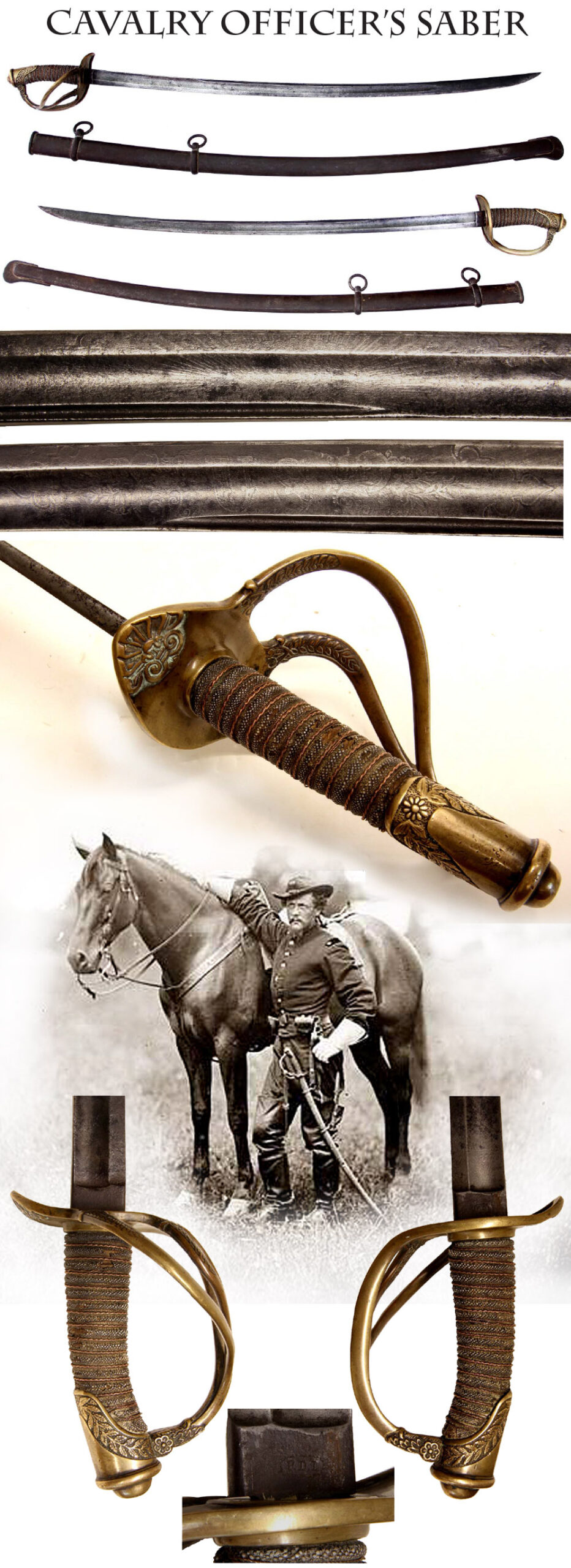
13-08-05 – 1840 Pattern United States Cavalry Officers Saber:
The real deal — mounted cavalry officers saber as carried by Jeb Stuart, the Custers, and virtually all the dashing commissioned cavaliers both North and South. The substantial 1840 pattern officers saber was actually more commonly used during the Civil War than the 1860 pattern. The blade is more robust, and if you think they were only for show you only need to heft one. Regulation cast brass hilt with floral motifs, sharkskin grip with wire binding showing the mix of coil and twist that marks it as a more expensive product. PDL marked ricasso for Peter D. Lunenschloss, who supplied blades and swords to a number of American dealers including Tiffany. Blade is Very Good, no edge nicks, some evidence of light sharpening years ago. There is a little crustiness at the ricasso, slight darkening to silver and gray with darker areas. The etching is very legible. US on one side amid floral designs, and an eagle on a sunburst background on the other. Scabbard is regulation all steel type. Officers could choose scabbard mounts with varying degrees of fanciness. This a practical plain scabbard for field service with iron mounts like the enlisted versions. Separate scabbard throat is in place, but the retaining screw was long ago lost. If you love the cavalry you will love this saber. This is a real fighting cavalry officers blade and it was absolutely carried during the Civil War. Handsome, solid, and shows honest period use.
$1,395.00
Click Here to E-mail Us!
Call us @ 419-842-1863
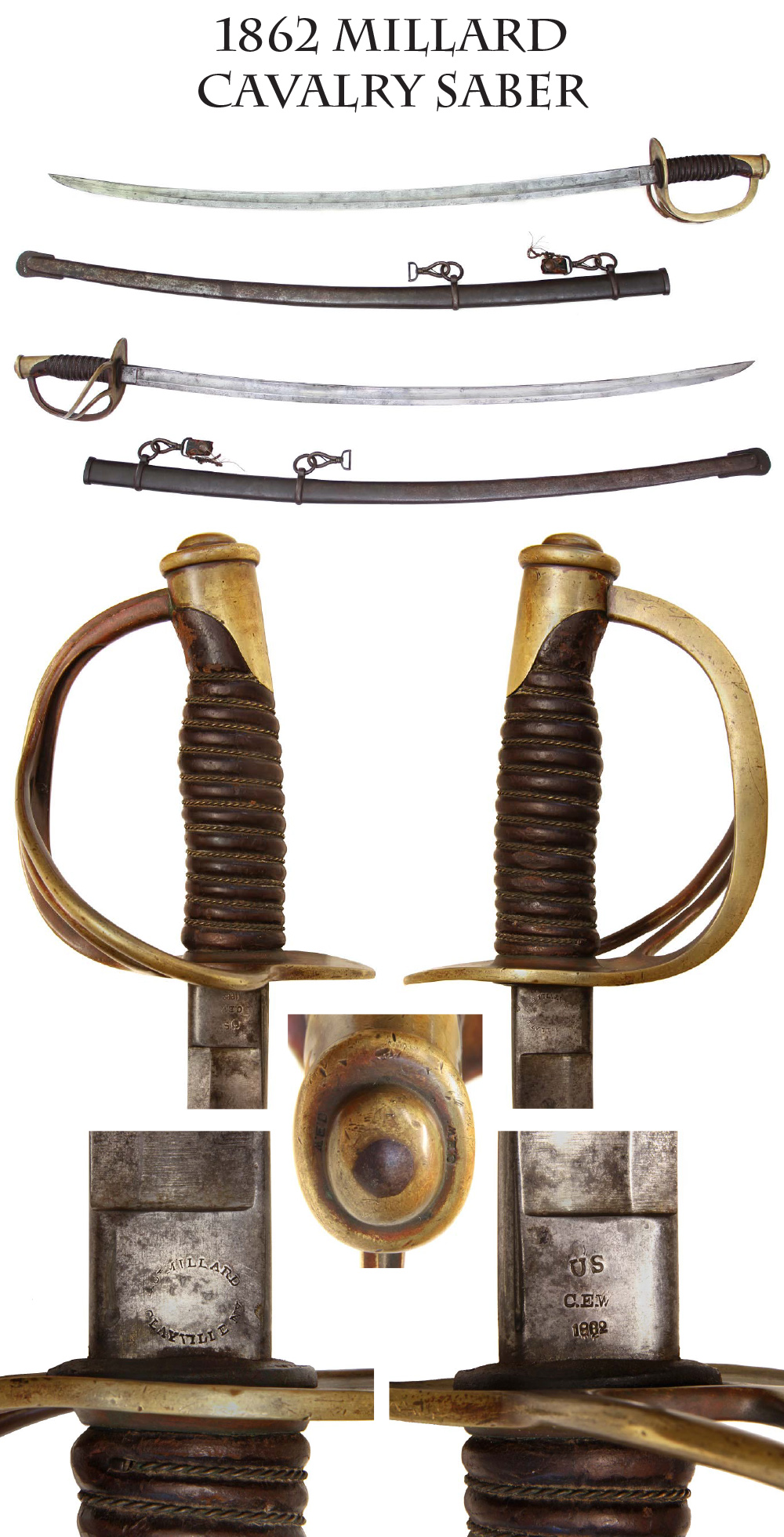
13-08-06 … Ultra Desirable 1862 dated US Cavalry Saber by Millard.
This is the regulation US cavalry enlistedmans saber used throughout the Civil War. There were many contractors producing swords for the US government. Millards work is especially sought because his swords are scarce – (largely due to the small number he contracted to produce), – he produced them early in the war, – and he dated them with the 1862 date. All these elements make the Millard sabers highly collectible. The blade is overall bright turning silver: Still shows traces of the original final cross polishing near the ricasso: Clear US / C.E.W./1862 on one side of the ricasso and Millard over Clayville on the other, with the left of the Millard name just a tad lightly struck. Nice mellow patina on the brass, full original grip leather and twisted wire both in superb condition. The grip leather is wonderful with just the slightest scuffing and wear. Original leather washer (bumper) still present where the guard rests on the scabbard throat … Has inspector stamps on the pommel cap, and an undisturbed tang peen showing the sword has never been disassembled or messed with. The original scabbard is in likewise very good condition with an even smoky dark patina, and two original commercial swivel snap hooks still in place. The swivels are typical of the private purchase items made by an experienced cavalryman who wanted to be able to unhook his saber quickly. There is still a portion of saber hanger strap in one of the swivels. Scarce, desirable maker, early date, and attic fresh condition. This one is a dandy
… $1,175.00
Click Here to E-mail Us!
Call us @ 419-842-1863

13-08-07 … One of my favorite recent finds … Super Condition 44 caliber Percussion Target rifle signed F Wassmann / Washington. D.C.
Very stylish 1850s or early 1860s target rifle with deep crescent butt, pronounced cheek rest, finely checkered wrist, S-curved and reverse-S-curved finger rest and trigger guard, with a key retained octagon barrel. All original including the rammer. Sling swivel on butt, loop for upper swivel is present on second rammer pipe. Wonderful short tube rear peep sight, front sight is a hinged aperture example. The false muzzle with warning post is present and has preserved the muzzle perfectly. The barrel is dovetailed for a rear sight above the barrel key, but likely no sight was ever installed here. The 44 caliber bore bears DEEP, SHARP rifling … I cannot find a bore light small enough to drop down the barrel to examine the condition at this writing … but will get one by the time you are reading this. Wassmanns name and address are stamped on the top barrel flat near the dovetail … Internet research shows he was an immigrant from Hanover (Lower Saxony) Germany and is listed in the 1860 Census as Gunsmith in Georgetown District of Columbia. We have seen an 1860 era telescopic sight which also bore an engraved signature of F Wassmann Washington DC. Apparently Mr. Wassmann was keenly interested in true precision marksmanship. Wassmanns finely crafted lock is married to a single set trigger to allow the shooter to touch off the gun with the simple brush of his trigger finger. Condition is very, very good to fine with faded case color on the lock and plum color mixed with blue and oxidized blue on the balance of the steel. This is one handsome gun! Stock is Excellent with sharp edges and crisp checkering. The round German silver patchbox is beautifully hand engraved with floral motifs around a central panel with a stag and tree. Underside of stock has the small hinged trap for percussion caps, it is likewise floral engraved. There are even some bullets still in the patchbox. The rifle is a tangible exhibit of a master gun makers talent and ability. In our world of factory produced military arms these hand crafted treasures are truly a refreshing change of pace. It is absolutely typical of some of the civilian rifles brought into the war by Sharpshooters, and is perfect to display with sharpshooter items. We know Abe Lincoln fired a Spencer carbine on the White House lawn — He would have shot better if hed been using this rifle. Top notch high grade rifle that I had to fight with myself not to price at over three grand. Weighs just under eleven pounds
… $2,850.00
Click Here to E-mail Us!
Call us @ 419-842-1863

13-08-08 … Springfield Model 1816 Conversion with Bayonet.
Attic condition and in the black. Nicely dated Spring/field / 1838 in three lines behind the hammer. Typical cone-in-barrel arsenal conversion with the brass flash pan ground off flush with the lock plate and a percussion military hammer installed on the tumbler, with the barrel tapped for a cone. Untouched crusty brown metal overall, with visible marks on butt plate tang, lockplate, etc. Has distinct visible cartouches in the wood. Dings and divots here and there, a small bit of wood out near breech plug tang, a couple of small carved initials. Shows use, bruises, wartime bangs, but no abuse nor neglect. Also present is its well aged and beat-up socket bayonet that is basically jammed on the barrel. The bridge over the mortise slot is broken, the socket is slightly bent, the US is visible at base of blade and condition matches the gun. Original ramrod is present (slightly bent), all the bands, sling swivels, front sight, etc are in place. Surprisingly good edges to the wood.
This is the typical early Civil War long arm. When percussion arms were adopted the government went through its arsenals and armories and selected only the most recent and better condition guns for conversion from flintlock. This one obviously made the cut. It has seen a lot of history and is just the sort of musket to be handed down in a family. Perfect for display with Union of Confederate effects from the period 1861 1862 … and appropriate for Confederate display through 1865. Gun and bayonet
… $975.00
Click Here to E-mail Us!
Call us @ 419-842-1863
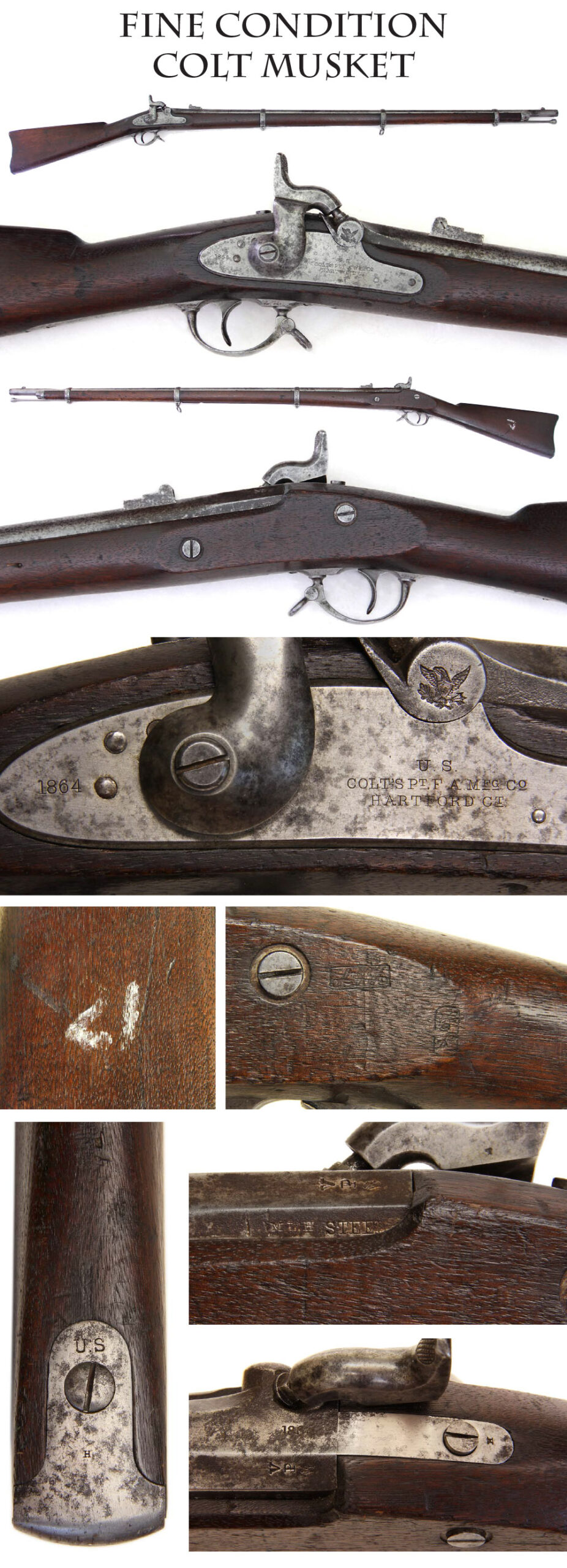
13-08-09 … Very Good to Fine Condition Special Model 1861 Colt Rifle Musket.
This is a gun collector’s gun: strong wood, good metal, crisp marks, mechanically perfect. Sharp 1864 date to rear of hammer, US/ Colt’s Pt. F. A. Mfg Co./ Hartford Ct.” forward. Sharp eagle on bolster. Matching 1864 barrel date, sharp V/P/eagle on left barrel flat, inspector initials and “Steel” on side flat. Two visible cartouches in the wood opposite the lock. Sharp “lock table” edges around the lock. Original rod, bands, swivels and sights all intact. Bands are correct screw tightened variety without band springs. A little bit of percussion cap firing corrosion on top flat near nipple partly hitting the date. Metal overall smooth with mottled silver and pewter color. Small number “21” in old white paint on inboard side of butt shows the gun was in military racks at some point. It could be removed but I like it as part of its history. Colt introduced a number of innovations in his “special model” rifle muskets that the US government adopted and his rifles are well sought-after not only because of the fame of the maker but as important steps in US arms development. Excellent bore. 100% original, 100% complete, mechanically perfect … and it is a Colt
… $2,250.00
Click Here to E-mail Us!
Call us @ 419-842-1863

13-08-10 … CS and US Used Austrian Lorenz Rifle with bayonet.
The 1854 Pattern Austrian Lorenz rifle was well regarded by Northern and Southern troops and imported by both sides in quantities second only to the Enfield patterns. This gun is .54 caliber and complete. This is a very good to fine example, free from defects. Has typical lighter color European wood stock. Block sight at rear and front sight mounted on an oval base set diagonally to guide the spiral mortise of the four-sided bayonet with locking ring. Wood is very good, very slight couple of chips to upper edge of barrel channel. Standard cheek rest on left butt stock. Barrel bands, springs and swivels firmly in place, as is the original ramrod complete with the brass ring and drilled hole for use with a cleaning rag or with a torsion bar for the purpose of twisting a worm into the nose of an unfired bullet one wishes to remove. Inspector marks visible on barrel edge. 860 dated lockplate (the Austrians used only the last three digits of the date!) Metal generally smooth light gray with some mottling. Iron nose cap and butt plate show some dimpling corrosion but not bad. Lockplate and hammer show darker patina having been hardened at the time of manufacture. Loads of these were issued to Tennessee Confederates and even the Wisconsin Iron Brigade received them mid war. A most appealing CW rifle appropriate to display with US or CS soldier effects. This one complete with the original quadrangular socket bayonet which is worth $150 all by itself
… $1,350.00
Click Here to E-mail Us!
Call us @ 419-842-1863

13-08-11 … Model 1861 Springfield Contract Musket signed Watertown 1864 with Bayonet.
Very good example of one the 1861 Springfield pattern rifle muskets made by a private manufacturer on contract to the Federal government. This one by Charles Hoard of Watertown, New York. Identical in every way to the Springfield except for the markings. Very clear 1864 date behind the hammer, eagle/ U.S./ Watertown forward. Correct hammer and screw bolster, second type Springfield style rear sight. US marked butt plate tang, various small sub-inspector marks, clear V/P/eagle proofs on barrel flat. Very visible ink wood inspector cartouches opposite lock. Some rounding to edges of wood, minor old dings and specks. Metal generally smooth, light silver in color. Wood with warm brown tones and some deeper color here and there. All swivels, bands, rod and springs in place. Mechanically perfect with good bore. Original .58 bayonet, with locking ring, is present and it has a shorter (shortened) blade by about two inches. Still looks great with the gun
… $1,450.00
Click Here to E-mail Us!
Call us @ 419-842-1863
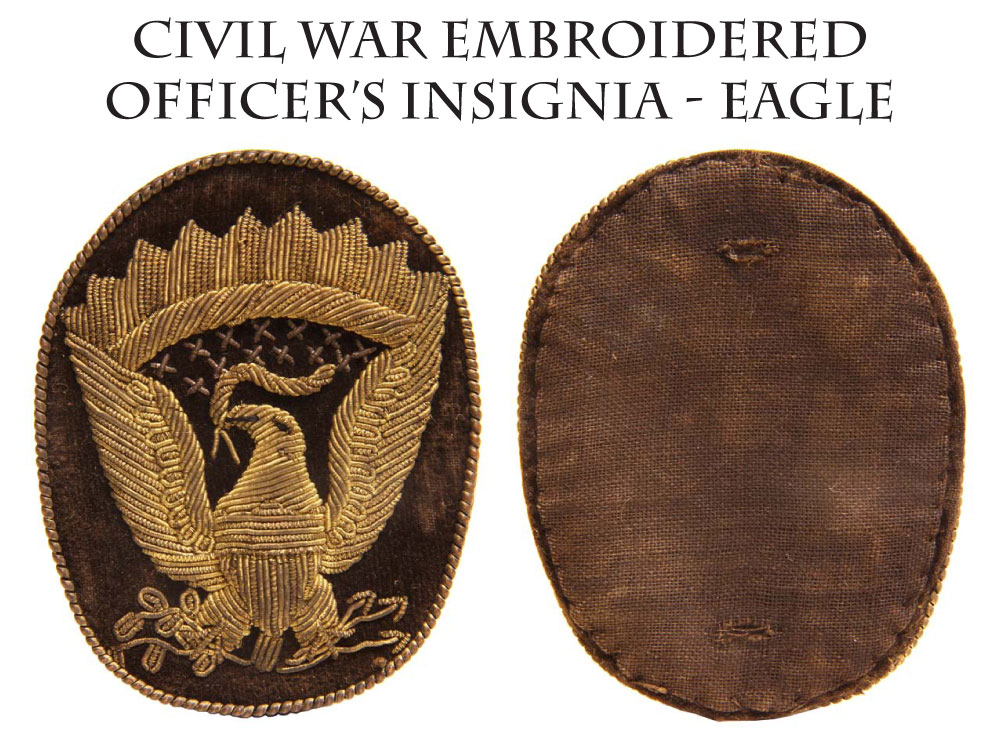
13-08-12 … Hat Insignia: Officers Embroidered Side Eagle.
This is the regulation hat insignia to be worn by officers of all branches of service on their hats to hold up one side of the brim. They were made by many different suppliers of uniform insignia and are a collecting field in their own right. The outer jaceron wire border is in place. The eagle with branches, arrows, and stars and sun rays above is embroidered on black velvet which has oxidized over the past 150 years to a slight brown. The original fabric backing over the interior metal plate for stiffening is complete and still tightly stitched. The two fastening loops are missing, but that matters little unless you were planning on wearing it, in which case you can affix a couple wires. These have always been scarce and this is a very representative example. Measures approx. 2.6 x 2
… $595.00
Click Here to E-mail Us!
Call us @ 419-842-1863

13-08-13 … 143rd Infantry Officer’s Hat Insignia.
Another piece of regulation embroidered headgear insignia. The oval hunting horn branch insignia of the infantry surrounded by a jaceron border (French for twisted wire). The horn is embroidered with gilt thread and sequins at the bell of the horn. The numerals “143” in false-embroidered silvered brass are pinned in the center of the horn to indicate the regiment. Small wear spot present on lower left front. ;This example was “really there” as evidenced by the addition of the regimental numerals, it is not something that sat in a box at Schuyler, Hartley and Graham for twenty years. Due to the high numerical designation (143) we know that it had to have been worn by a New Yorker, Pennsylvanian, Ohioan, Illinoisan, Indiana Hoosier, or USCT officer. Those are the only units carrying regimental designations to 143 or more. Two flat loops on the reverse for attachment to the hat still in place. Excellent condition in all respects and measures a healthy 2.5 x 3.5 inches.
… $650.00
Click Here to E-mail Us!
Call us @ 419-842-1863

13-08-14 … Inscribed Heckmans Star Brigade, 23rd Massachusetts Eighteenth Corps Badge.
When I saw this badge I had to have it. Stan Phillips used a very similar Eighteenth Corps badge for the cover of his classic book on Civil War Corps Badges and this one is every bit as nice- in fact, I think a notch or two better. Beautifully engraved cross with foliate sides with a double ric-rac border, numerous curling caterpillar flourishes, and shaded five-pointed star at top. Across the center in script is, Lieut. Jos. H. Baker / Co. G 23rd Regt. and in the lower area amidst flourishes, Mass. Vols.
Baker was a 27 year-old cordwainer living in Beverly, Mass., when he enlisted at a private in the regiment on 8/2/1862. On 8/5/1862 he mustered into “G” Co. and re-enlisted on 12/2/1863. He made sergeant 11/9/64 and 2nd Lieutenant 6/2/65. Although not mustered in at that rank, he would have had the commission certainly been performing the duty. After the war he was a member of GAR Post # 89 (J. H. Chipman, Jr.) in Beverly, Mass., and died 1/7/1916.
The 23rd had been part of Burnsides Coastal Expedition, fought in several engagements, and was stationed in New Bern, NC, when Baker joined it in the Fall of 1862. During the time Baker was with it they were in several expeditions and fights at Kingson, Whitehall, Little Washington, etc. At Whitehall they lost pretty heavily, 16 men were killed or mortally wounded. They moved up into Virginia in early 1864 and became part of the 18th Corps, which served in the Army of the James and the Army of the Potomac in Grants 1864 campaign, seeing action at Port Walthall Junction, Arrowfield Church, Drewrys Bluff, and Cold Harbor, where they lost 10 killed and 39 wounded, and then in front of Petersburg before returning to North Carolina, where they fought their final engagement at Wises Forks in March, 1865, losing 3 killed and 10 wounded. They were musted out in Massachusetts in July, 1865.
This is a super badge. Very high quality, jeweler made, silver with a T-bar fastening pin on reverse. Many 18th Corps badges use triangles and stars in their designs along with the foliate cross. Some of these were because of various directives meant for restricted use to differentiate staff officers and the like, but which made their way into general use. In this case, Id like to believe there is the possibility that Baker wanted the star motif used on his badge as a symbol of the 1st Brigade, 2nd Division, 18th Corps, in which his regiment served. When they moved north into Virginia they were commanded by General Heckman, whose command was nicknamed Heckmans Star Brigade. Whatever the reason for its use here, it helps make one world-class inscribed corps badge. It is the first corps badge Ive obtained directly from the family in MANY years. I would prefer to trade this for a comparable Michigan or Ohio badge, or for an inscribed knife or inscribed personal item of some rarity.
What do you have for trade???
Click Here to E-mail Us!
Call us @ 419-842-1863

13-08-15 … Western Theatre Civil War Identification Disk.
At the other end of the spectrum from the highly sophisticated inscribed Massachusetts badge above, here is a comparatively simple badge from a mid-western unit. The most exciting aspect to this artifact is that while researching it on the internet I found the camp photo we show above. The owner of this dog tag, Lieutenant Edgar Isbell, is THE officer standing on the right in the above camp scene at Picket Post No 1! The quality of the internet image is not great but when I enlarged the inscription I could in fact read the name Lt. Isbell on the image mount. I was incredulous at first — then darn excited. It is amazing what Google Images has in its archives. I can count the number of western theatre identification disks I have owned over 45 years on two hands. Western troops were so active and so mobile and so seldom in large camps near big cities that it was not very practical for them to find a sutler to supply them with the luxuries so common in the east. It was also not economically feasible for most sutlers in that rural theatre to try to furnish them. The vast majority of ID disks that show up were furnished by sutlers and peddlers to troops camped around Washington, DC, early in 1862. Here is an extremely scarce western example. The disk is a variant of the popular War of 1861 / Eagle style disks that we usually see in brass from eastern units. This one appears to be struck in Brittania or other white metal. The name and unit stamping of individual letters and numbers, are far larger than we see on the eastern examples. This disc is filled out for Edgar Isbell / 47th / Illinois, Shows honest use with a well worn suspension hole. Isbell was from Pekin, Illinois, and enlisted in the 47th on 8/16/61 as First Sergeant in Company E. He was commissioned Second Lieutenant 9/2/62, and served until discharged 11/6/63. The regiment was mustered in at Peoria in August, 1861, and then stationed in St. Louis, MO, at Benton Barracks. During the time he was with it, the regiment served in the Army of the Mississippi and Department of the Tennessee in the 13th, 16th and 15th Corps. They saw action first in Mississippi at Farmington in May, 1862, then later at Iuka, Corinth and Vicksburg. At Corinth they suffered 30 killed and over 100 wounded. They crossed the Mississippi at Grand Gulf and aided in the capture of Jackson, and at Vicksburg they took part in the first charge on the Confederate works, losing 12 men killed, and helped defeat a Confederate force at Mechanicsville, 30 miles outside Vicksburg in June. If I were to guess, I think it most likely Isbell obtained the disk while at Benton Barracks. There was enough commercial activity there from the presence of large groups of soldiers that it is likely an enterprising merchant decided to try his hand at identification disks. This is a darn scarce western variant of the standard eagle device and a very rare example being from a good western unit with real field service. I do not recall ever owning another of these eagle variants. And how often do we find a wartime camp photo showing the owner of one of our artifacts?
One heck of a great personal item
… $975.00
Click Here to E-mail Us!
Call us @ 419-842-1863

13-08-16 … Mountain Man Frontiersman!
A Long Haired contemporary of Davy Crockett & Jim Bowie! Frontiersman? Texan? This guy means business and has THE LOOK of an Indian Fighter and Bear killer.
The lean-mean, long haired frontiersman is a ninth plate daguerreotype … the woman is a sixth plate portrait.
Taken about 1849 or so, matted, framed, under glass, in typical leatherette hinged cases. They came together and are probably a couple, the woman looking elderly with glasses, a white lace bonnet, and dark dress or cloak. So far, pretty unexceptional. But look at the man! This is someone you move out of the way for on the sidewalk! Bony faced, tough as nails demeanor, bushy eyebrows, hair combed up high on the top and down below the collar behind his ears in the fashion popular when he was at his prime about twenty-five or thirty years before, circa 1825 or 1830, a stern look that you would never want to mess with, and what looks like it could be a prominent scar along the lower line of his cheekbone. This guy has gotten dressed up for a formal portrait – high collar shirt, black necktie, vest and coat, but that countenance is straight off the frontier, probably born about 1790 or a bit earlier, a contemporary of Crockett and other restless types. Matted, framed and glassed in a leatherette case like the Mrs. has. Facing pads in place. Decorative patterns embossed on the cases. Separations at the hinges, no big deal. If you have a big frontier Bowie knife and a large bore single shot pistol, this might be the guy who owned them. Superb on all fronts
… for the pair … $275.00
Click Here to E-mail Us!
Call us @ 419-842-1863

13-08-17 … They Helped Win the Gettysburg of the West!
Nice family identified tintype of James Thew, mustache and goatee, posed full standing in a studio wearing a shell jacket and hat with its wide brim turned up on either side. Posed holding a cavalry saber point to the ground for the camera. Three minor marks at the right edge, otherwise very good. Has mat and frame. Image is a trimmed quarter plate and came housed in the Washington monument case shown below. At Westport, Missouri, called the Gettysburg of the West, more than 30,000 troops were engaged and the battle ended Confederate General Sterling Prices hopes for Missouri. Thew served in the 9th Wisconsin Light Artillery, which was part of Blairs Brigade in General James G. Blunts Provisional Cavalry Division. So chances are the battery served as horse artillery, which makes sense because a lot of their service was spent not only holding western forts against Indian attack but also escorting wagon trains and mail coaches in Colorado, New Mexico, and Kansas. It also makes sense of the cavalry saber with which he poses. In any case, at Westport Union General Curtis personally led them into place on the Confederate left flank by a small bypath, along with his personal escort, and by firing into the Confederate left and rear they gradually turned the battle in the Union favor.
James Thew was from Werner, Wisconsin, and signed up in the 10th Wisconsin Light Artillery in November, 1861.
The battery was organized at New Lisbon and mustered in in February, leaving the state for St. Louis in March.
On April 1, 1862, a lieutenant and 45 privates transferred to the 9th Battery, and Thew was apparently in this contingent
for CWdata lists him as a transfer to that unit at a date unstated. He shows up as a private, an artificer, and eventually a corporal, serving until muster out on 4/20/65.
The 9th Wisconsin Battery embarked for Leavenworth, Kan., on April 3 where it prepared for a march across the plains. The Union Army covers its history of campaigning on the plains as follows: On the 26th it proceeded by way of Fort Kearny and Julesburg, to Denver reaching there on June 2 after a march of 700 miles. On June 4 it proceeded to Fort Union, New Mex., and soon afterward Lieut. Crocker with the left section marched to Fort Larned and remained there until Dec. 1864. On July 5, the right section marched to Fort Lyon, where it joined the center section. These two sections remained in Colorado until April 26, 1864, either at the fort or at Denver, making frequent marches to the distant frontier. The most noteworthy of these was made by Lieut. Edington with one section in June 1863. The march was a distance of 240 miles and it was made in three days — the quickest in the history of the war at that date. In April, 1864, the battery marched to Council Grove, Kan., where it remained as garrison of the town escorting trains and U. S. mail coaches over the road until August, when it went to Fort Riley. In July Lieut. Edington with one section joined in an expedition against the Indians at Fort Larned. Late in August he joined an expedition to Smoky Hill, where the Indians were defeated in a well contested engagement. In July, 1863, Lieut. Crocker and the left section held Fort Larned against the combined forces of the Indians in that locality. In Oct. 1864, Capt. Dodge, with 4 guns, joined the command of Gen. Curtis and participated in the campaign against Price in Missouri and Arkansas. In the battle at Westport the battery broke the charge of a column, 6,000 strong, three successive times. In Dec. 1864, this portion of the battery proceeded to Fort Leavenworth, where soon afterward it was joined by the other detachments preparatory to reorganization of the veterans. The aggregate distance marched by the battery and detached section during these three years was nearly 15,000 miles. The veteran battery was organized Jan. 27, 1865, with Lieut. Crocker as Captain. On March 26 Lieut. Edington with one section marched to Fort Scott and remained there until June 16, when he proceeded to Fort Riley. This section left Fort Riley for western Kansas and was mustered out at Fort Leavenworth Sept. 30. The original strength of the battery was 155. Gain by recruits, 63; reenlistments, 78; total, 296. Loss by death, 6; transfer, 1; discharge, 56; mustered out, 233. This image came in the super thermoplastic case shown below with a modern family note behind the image identifying Thew. A fine armed tintype with Wisconsin history
… $350.00
Click Here to E-mail Us!
Call us @ 419-842-1863

13-08-18 … The Hero of Gettysburg!
Wonderful full standing studio portrait of the hero of Gettysburg, John Burns, with a rifle, shown leaning on a balustrade, musket butt on the floor, muzzle cradled in the crook of his arm, wearing his trademark old tophat and tailcoat. Wonderful period inscription on reverse: The Patriot Burns of Gettysburg Pa Presented by Rev. D.H. Pierson Jan. 12, 65. Burns was a War of 1812 veteran and local character at Gettysburg who did not take kindly to the Confederate incursion and joined the Union battle line in the first days fighting, garnering a couple of wounds and nationwide fame for his gumption. Lincoln wanted to meet him. Bret Harte wrote a poem about him. Everyone wanted a photo of him. When he died his epitaph read simply Patriot. R.A. Lewis, NY, backmark. Very nice tones and composition, one of the most famous Gettysburg personalities and a striking image on all fronts
… $595.00
Click Here to E-mail Us!
Call us @ 419-842-1863
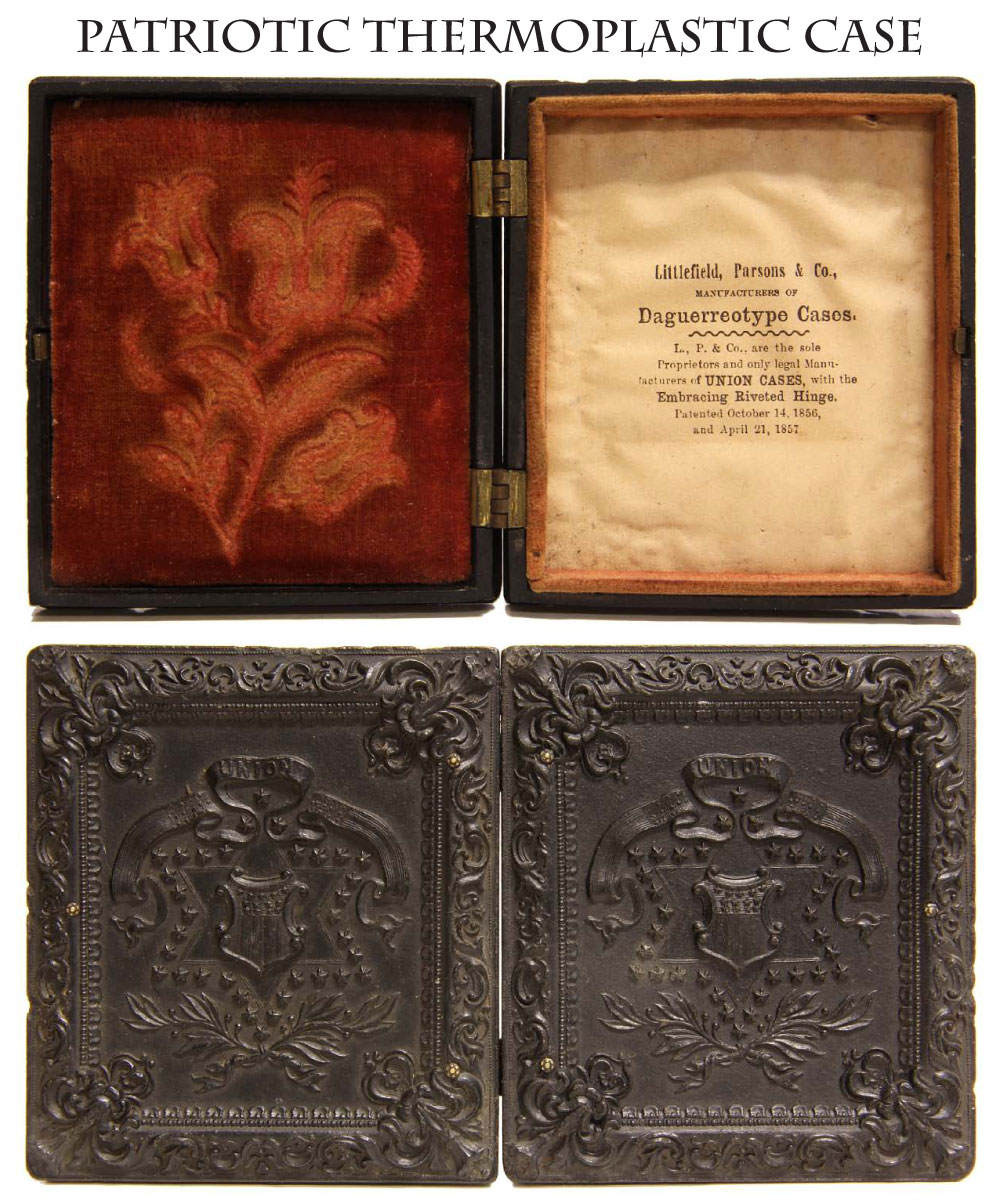
13-08-19 … Sixth Plate Patriotic Thermoplastic Photograph Case.
Littlefield and Parsons patented Union case, with 1856 and 1857 patent information on the interior paper lining of one side. U.S. shield inside a six-pointed star of stars, Union on a ribband at top, tied branches wreathing it below, floral border. Very good condition, a few minor edge nicks, overall solid with good detail case
… $250.00
Click Here to E-mail Us!
Call us @ 419-842-1863

13-08-20 … Sixth Plate Tintype of Federal Soldier
in regulation cap and enlisted mans frock coat, posed with a pre-war militia belt and sword. The sword is a straight-bladed double-edged sword with cruciform guard and knights-head pommel of typical militia style ca. 1840. In fact Harold Peterson assigned the title of Non Regulation 1840 NCO Militia Sword to this pattern. Though not visible in the image the grips on these swords are finely fluted bone. Also circa 1840s is the rectangular flat belt plate with eagle and border worn by our hero. The sword scabbard shows at his side. Noting the tall collar on the frock and pre war militia gear we can surmise that this photo was taken circa 1861-1862. Mid-thigh up pose. A couple of minor lines in the emulsion, generally good and clear. Our boy looks just a tad concerned, as well he might, given what lay ahead. Housed in common case w split hinge
… $275.00
Click Here to E-mail Us!
Call us @ 419-842-1863

13-08-21 … Extra Fine and Extremely Scarce Quarter Plate Washington Monument Thermoplasic Case.
Union Case, improved … S. Peck & Co. Manufacturers on interior paper lining. Facing pad is a luxurious purple velvet with impressed wreath. Geometric and floral borders surround an oval panel. Back oval panel is blank, front oval panel shows the Washington Monument in Richmond, Va., which was unveiled on Washingtons birthday in 1858. A fine tight case, nice brown tones, sharp detail, and no edge nicks. A very fine case deserving a very fine image. The artwork of the case alone is worth exhibiting solo, but with the Richmond connection a killer Reb image would be totally appropriate for display inside. (Our Wisconsin soldier above is what actually came in this.) One of the rarest of Patriotic cases I have been able to offer of late
… $595.00
Click Here to E-mail Us!
Call us @ 419-842-1863

13-08-22 … Inscribed Identified 79th Ohio Soldiers Pocket Bible.
Standard soldier Testament – Cloth covered, American Bible Society, published in 1864. Period pencil inscription inside the front cover: Ed. Retallick / Co. H / 79th Regt. OVI Very Good condition, minor chipping to edges. Edmund Retallick enlisted at age 20 as a private on 8/15/62 and mustered into Co. H of the 79th Ohio on 8/23/62. He served through the war, mustering out 6/9/65 at Washington, D.C. The 79th served in the Army of Ohio and Army of the Cumberland, doing guard duty for the early part of its service and then joining the 11th and 20th Corps in the Spring of 1864 for the Atlanta Campaign. They fought at Snake Creek Gap, Kennesaw Mountain, and Peachtree Creek, where it lost about fifty percent casualties and ended up at Atlanta with 182 out of 600 who had started the campaign. It was on the March to the Sea and fought at Columbia, Averysboro, where it captured three enemy artillery pieces, and Bentonville. When the regiment mustered out it had lost about 1,000 men … more than the original number who had mustered in. For all the ease of its early service, this was one hard-fighting unit during the second half of the war.
Top notch condition and very displayable
… $265.00
Click Here to E-mail Us!
Call us @ 419-842-1863

13-08-23 … Heavily Armed! Sixth plate Tintype of a Federal soldier armed to the teeth with a Smith and Wesson .22 revolver.
Mustachioed Yank in a half-length seated pose, wearing his regulation enlisted frock coat and a narrow belt that might have a small holster on it for the diminutive revolver he holds prominently for the camera. Many well-meaning friends and relatives sent new recruits side arms for personal protection or last ditch use on the battlefield. Our young volunteer may be showing off the pistol for the folks back home to show that he had received it. Samuel Clemens (Mark Twain) wrote about his experience with the Smith & Wesson .22 and it bears reprinting here from Twains
Roughing It
I was armed to the teeth with a pitiful little Smith & Wesson’s seven-shooter, which carried a ball like a homopathic pill, and it took the whole seven to make a dose for an adult. But I thought it was grand. It appeared to me to be a dangerous weapon. It had only one fault — you could not hit anything with it. One of our ‘conductors’ practiced awhile on a cow with it, and as long as she stood still and behaved herself she was safe; but as soon as she went to moving about, and he got to shooting at other things, she came to grief. A wonderful period illustration showing exactly the same model. The guns are quite common … photos of men holding them are quite rare. Housed in a half leatherette case
… $395.00
Click Here to E-mail Us!
Call us @ 419-842-1863

13-08-24 … The Real Deal An Actual Combat Carried Regulation Issue Federal Infantrymans Cartridge Box and Sling.
Obviously used in the war, brought home by the soldier, and hung up as a memento of his army service. Soldiers initials carved on the back edge: MHR. Full length bridle leather shoulder sling cut for the circular eagle plate, which has been lost to time (easily replaced). The oval box plate remains firmly in place on the front flap, still held by its leather thong. Leather shows lots of original finish and is still flexible. Some crazing and creasing from use – the diagonal crease lines on the cover corners show where the soldier was reaching in for cartridges! Tins, pockets, straps, and buckles all in place. Wilkinson & Cummings / Makers / Springfield, Mass marking very legible. They had substantial contracts in 1862 and 1863 together as partners and also individually. The key leather accoutrement in a Civil War Union infantry collection is the cartridge box rig. Made to carry forty rounds, twenty in the magazine trays on top and another twenty in reserve underneath. Remember the story of the Fifteenth Corps soldier? When asked by an eastern dandy where he displayed his corps badge, he slapped his cartridge box and said, This is my corps badge! About as appealing a box rig as I have seen in a long time
… $1,050.00
Click Here to E-mail Us!
Call us @ 419-842-1863
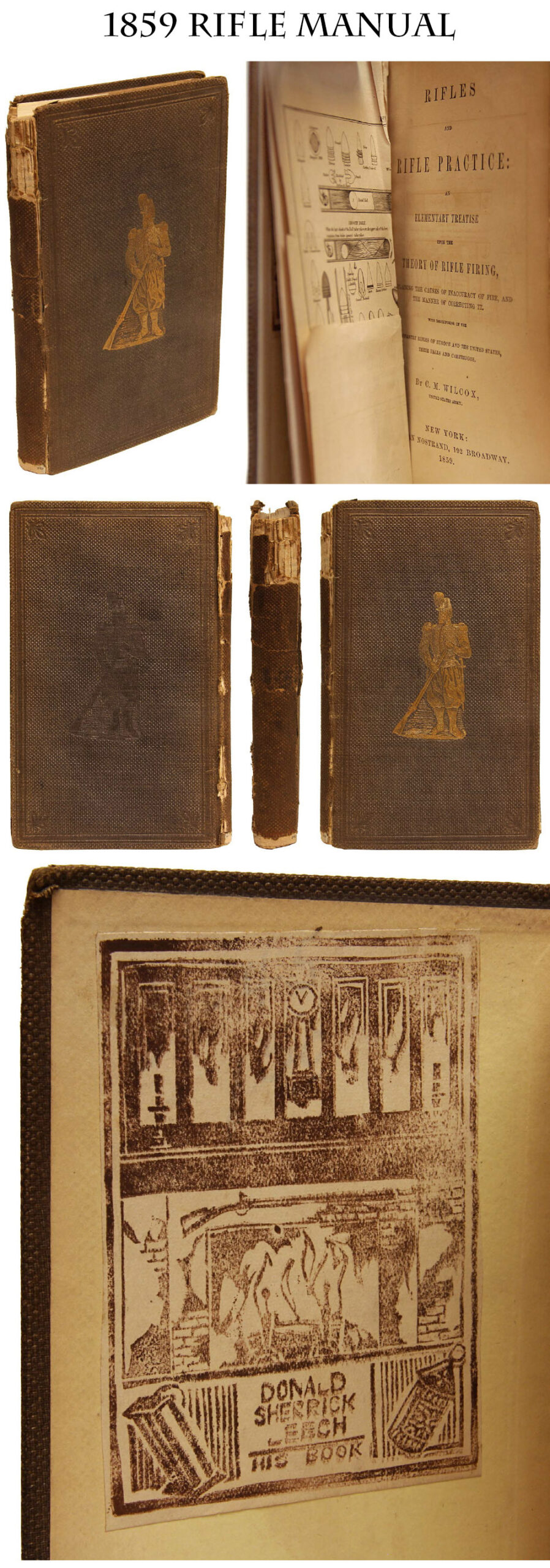
13-08-25 … Rare Army Manual:
Rifle Practice: an Elementary Treatise upon the theory of rifle firing … C.M Wilcox US Army 1859. Brown cloth bound. Superficial damage to the upper spine, cover slightly loose, previous owners bookplate inside cover. Embossed figure of a chasseur or light infantryman on the covers, the front figure gilt. Illustrations, fold-out plates. With the invention of the minie ball, which expanded to take the grooves of a rifle barrel, rifle armed troops became generally feasible on the battlefield and there was a craze for the theory and practice of rifle marksmanship and rifle armed light infantry on the battlefield. Here is one of the books dealing with the topic and just the sort of volume an officer would have in his personal military library in the field. Civil War manuals, regulations, and tactics books are widely sought as a window on how things were done on the battlefield as well as the theories current at the time. This is one of the harder volumes to get. 276 pages with numerous fold-out plates
… $195.00
Click Here to E-mail Us!
Call us @ 419-842-1863

13-08-26 … Joslyn .44 Cal. Cavalry Revolver with ULTRA RARE Holster
I just purchased these from the family descendants in Wisconsin. This holster is much rarer than the pistol, and a Joslyn is not a common revolver by any means – only about 3,000 were made in 1861 and 1862. This one bears serial number 189. The holster is adorned or reinforced along the edge of the cover flap with substantial brass rivets. I do not know if the holster was made with the rivets or if they were added by the soldier. My feeling is that they were put on at the factory or arsenal. I owned one Joslyn holster earlier last year that bore no such rivets, but this example appears to have been made with the rivets. There is wear on the leather, a few rivets are missing, the latch tab is gone, and there is some seam separation. The revolver is overall good to VG with two solder repairs where the back strap meets the frame and also where the inside grip strap meets the frame … the result of some nit-wit using the butt as a hammer and cracking these spots which the family then solder repaired. See photos which show the repair. Has clear Joslyn maker and patent markings, low serial number (189), smooth metal. Blued finish gone except for hints in protected areas. Some darker color near the muzzle, mostly a neutral dull silver, but cylinder shows some blue with a drag line at the rear. Checkering on grips is very good, showing wear but not worn excessively. The inboard grip, however, has a major crack that needs fixing and some chipping at the base showing where the nit-wit used it to pound something down. The holster is a military configuration and fits the revolver perfectly, and it has been with the Joslyn since the war. No toe plug, as is frequently the case on any CW holster. Minor abrasion and finish loss. A scarce set. It needs a tune-up mechanically. The cylinder will rotate when the hammer is cocked but the hammer will not stay on full cock. I will leave this project to you. This Joslyn and holster were definitely carried together in the Civil War. Cavalry? Navy?
… $2,450.00
Click Here to E-mail Us!
Call us @ 419-842-1863
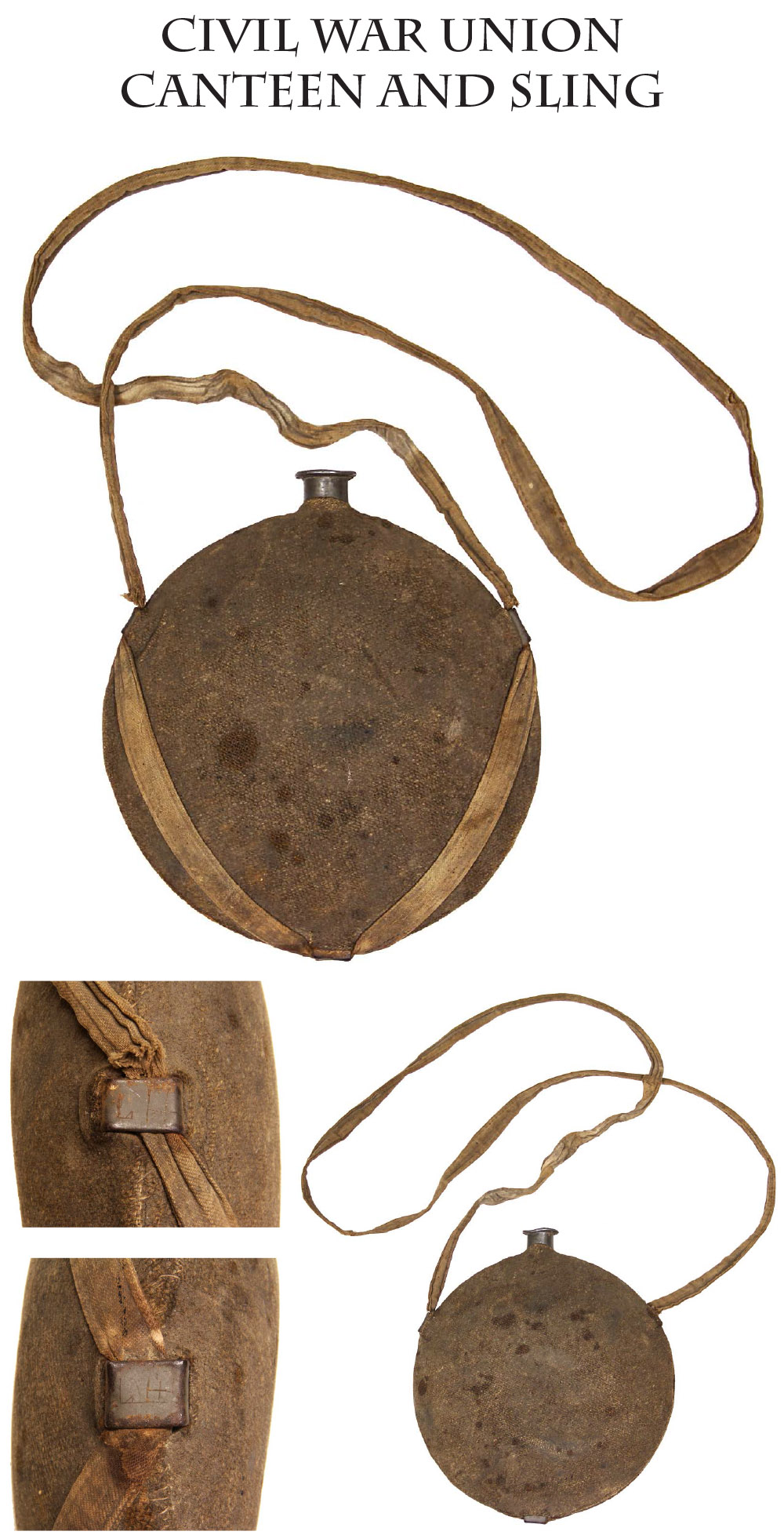
13-08-27 … Regulation Civil War 1858 Pattern Smooth Sided Canteen with Original Cover and Strap.
Most that I find lack the cover or the strap, or have ones that look suspiciously new! Here is an original and completely genuine untouched Civil War soldiers example. Gray wool body cover, characteristic loose weave, some stains here and there, one slight wear spot, but no tears or mothing. Original linen strap in place, full length, just a little abrasion at the tops of the brackets where the roughness of the metal wears the cloth or transfers rust. Lightly scratched in initials on each bracket, LH, undoubtedly the soldier who carried it. Lacks the cork stopper, which on this pattern would be secured with a doubled string cord. Originals show up from time to time and it should not be difficult to find one if you want to. I like it as is, just the way LH brought it home
… $345.00
Click Here to E-mail Us!
Call us @ 419-842-1863
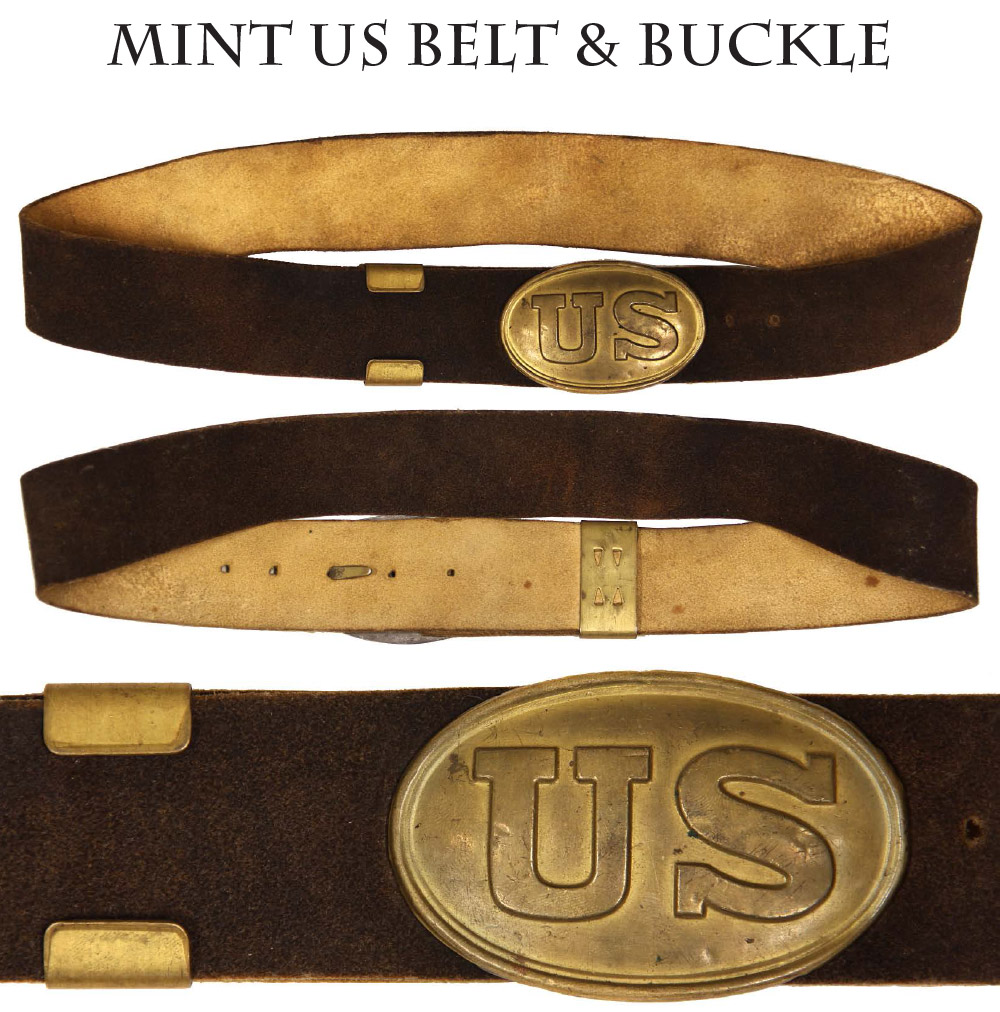
13-08-28 … Near Mint US Buff Infantry waist belt and US Buckle.
Regulation infantry enlistedmans belt and regulation arrow-back US oval belt plate. The buff leather loose end on this pattern uses a flat open stamped brass C-clasp keeper to keep the excess belt from drooping down. These keepers supplanted the standing leather loop belts fairly early in war. (See below for an example.) Nice dark color on the buff leather. If you add a cap box and bayonet scabbard you will have a complete infantry belt display. Most of my competition ask $650 for these mint belts … I can sell this spectacular rig for
… $550.00
Click Here to E-mail Us!
Call us @ 419-842-1863

13-08-29 … Original Civil War Cavalry Saddle Bags for the 1859 Pattern McClellan Saddle.
Ready to go on the saddle or add to a cavalry display. These were used to carry spare horse shoes, nails, curry comb, etc., extra ammunition, and sometimes for the troopers personal effects. This is the pattern developed for the 1859 McClellan, the quintessential wartime troopers saddle and are a key piece in a CW cavalry display. Solid connecting strap in one piece with the single central hole for the saddle bag stud at the rear of the saddle. These cross straps are often torn or broken in half from careless folding and handling- this one is solid (never fold old leather too tightly!) Overall decent black/dark brown finish. Crackling and crazing to the finish, but not a lot of finish loss. Still fairly flexible. I have left them alone and not tried to treat them with anything. They actually look like they were on a saddle until not long ago. Both bags are decent with solid seams and no tears. One is folded in on itself slightly making it look narrower than the other in the photos, but they are the same size. The fastening straps are partially present. One extends about an inch and includes the first hole. The other is about two inches and includes the upper two holes. Neither fastening buckle is present, but this doesnt show much. The horizontal fastening straps above the bags meant to pass through staples on the saddle protruding through slots in the cross strap are still present. The lower tie down straps that were intended to pass through loops on the saddle skirts are gone, but these were often cut off in field service as unnecessary. I don’t see any markings, but a better set of eyes might make something out. All in all, a good example of a scarce piece of Civil War cavalry gear, ready to place over the saddle bag stud on the rear of that cavalry saddle. Priced extra friendly at
… $650.00
Click Here to E-mail Us!
Call us @ 419-842-1863

13-08-31 … Wooden Sole Shoes.
Wood soles with leather uppers nailed to them and iron rims nailed on the bottom. These are sometimes referred to as clogs or plantation shoes. Similar patterns were produced for issue to Virginia, North Carolina, Georgia and Alabama troops during the war to save leather. Here is a clipping taken from an 1862 southern paper … The Southern Cultivator from Augusta, GA in July-August 1862 reports … “The manufacture of wooden shoes is now carried on quite extensively in Raleigh, N.C., by Messrs. Theim & Fraps. The enterprising manufacturers have in their employment some thirty hands, and are turning out about one hundred pair of shoes per day. The shape and size of the shoe are first marked and sawed out, and then it is bored and scooped out, and fashioned at the bottom and sand-papered, and lined, and painted, and topped with leather, and thus finished.” From later in the year we find reported…. “Shoes with wooden soles are being made in Mobile. They are said to be fully as light as those entirely of leather, and made with a neatness equal to that of the ordinary fabric. They can be furnished for about one-third the cost of a similar grade of all leather shoes.” This information is found in the November-December 1863 issue of The Southern Cultivator.
We also find … Columbus (GA) Enquirer – January 21, 1862 “Wooden-Soled Shoes. – We learn that the Georgia made shoes with double maple sole are in very good demand. Mr. Markstein has already filled a considerable order from Virginia, for army demand, we suppose. Several planters have been testing their merits, and the result in all cases proved favorable. In our own immediate vicinity, or in what might be properly called “The Army of Mobile,” they have been tried, and the report is so favorable that only yesterday an additional lot was ordered. We have no hesitation in saying that they will prove an excellent marching shoe. Some other article might better suit the double-quick movement, but for an all-day lick they will prove less fatiguing than a more elastic shoe. Besides, the foot is less liable to heat in them, no matter what kind of sock is worn, or even should the soldier find himself without any. One thing we must say – though that will not diminish their value among our boys – they’ll never do to run away in; indeed, they are a Southern shoe, and not designed for that kind of service.” Shown here in addition to the antique shoes is a photo of similar replica shoes being offered for reenactor use. They appear to be nearly identical.
You can click the following link to see that page in its entirety
http://www.veteranarms.com/ReproductionMuzzleloadersandFlintlocks/Boots.html
This pair of unused shoes surfaced earlier this year at a central Ohio estate auction. There was a Union officer’s field desk at the sale, but the auctioneer and family could not supply the name of the original owner. I do not know if these wooden sole shoes are examples of Southern made clogs brought home in 1865 by the owner of the desk or if they have some other 19th century civilian association. They are clearly made the same way as described in the wartime Southern newspapers, and are certainly an interesting pair of Civil War era shoes. The right shoe is made with grommets for the laces to pass through, the left shoe is not. Both have nicely carved wooden soles and heels with substantial reinforcing steel cleats or ridges along the outer edges of the sole and heel. The uppers in leather are nailed to the wooden soles. It is interesting to note that the replica CS shoes look very similar to these. Interesting early footwear
… $495.00
Click Here to E-mail Us!
Call us @ 419-842-1863

13-08-32 … Early War Buff Infantrymans Belt.
Very nice condition early war US infantry belt in buff leather with the early war style standing loop keeper and early stud back US plate. Excellent condition, just two small lengthwise slits in the belt for some reason. This would look great with an early war pattern square flap cap box and bayonet scabbard. The standing loops was replaced by the stamped brass C-clasp because the loops would shrink and soldiers sometimes had a hard time feeding the belt plate through. Most that survive have had the leather loop removed. Buff was originally black, but as with most CW buff that used iron dyes it has oxidized to a lovely dark brown color. A very, very scarce pattern in unaltered fine condition
… $650.00
Click Here to E-mail Us!
Call us @ 419-842-1863
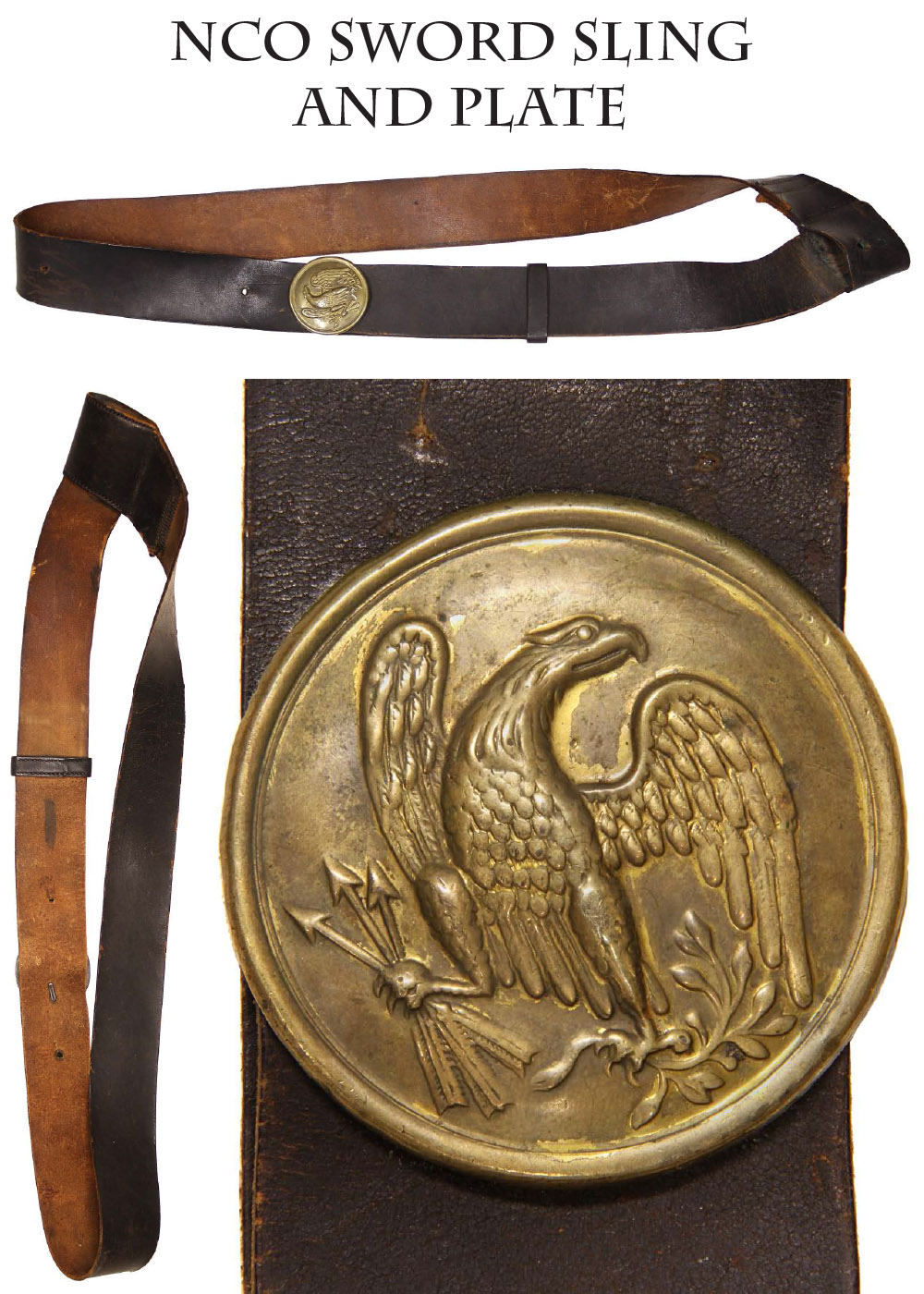
13-08-33 … NCO sword sling and eagle plate.
These shoulder slings were designed for musicians and sergeants to carry their swords. They utilize the 1839 pattern circular eagle shoulder belt plate with three hooks on the reverse to adjust the length of the belt/sling. This specimen has a lovely patina with much original gilt in the recessed areas. Reverse has three double wire hooks. These belts were used both for the musicians sword, and the NCO sword, this specimen is technically the sergeants version as it has the two open pockets for receiving the NCO sword and the bayonet. As is typical of Civil War production examples only one pocket has a hole for the sword scabbard hook and the bayonet was retained on the waist belt. NCO swords were regarded more as a badge of rank than a useful weapon and were usually relegated to camp and parade, but they definitely saw action on the battlefield as well according to many contemporary references and reports. It seems NCOs such as the regimental sergeant majors continued to carry them in the field throughout the conflict. A top notch specimen on all fronts. Rates an 8 on a scale of 1 to 10. Super
… $850.00
Click Here to E-mail Us!
Call us @ 419-842-1863
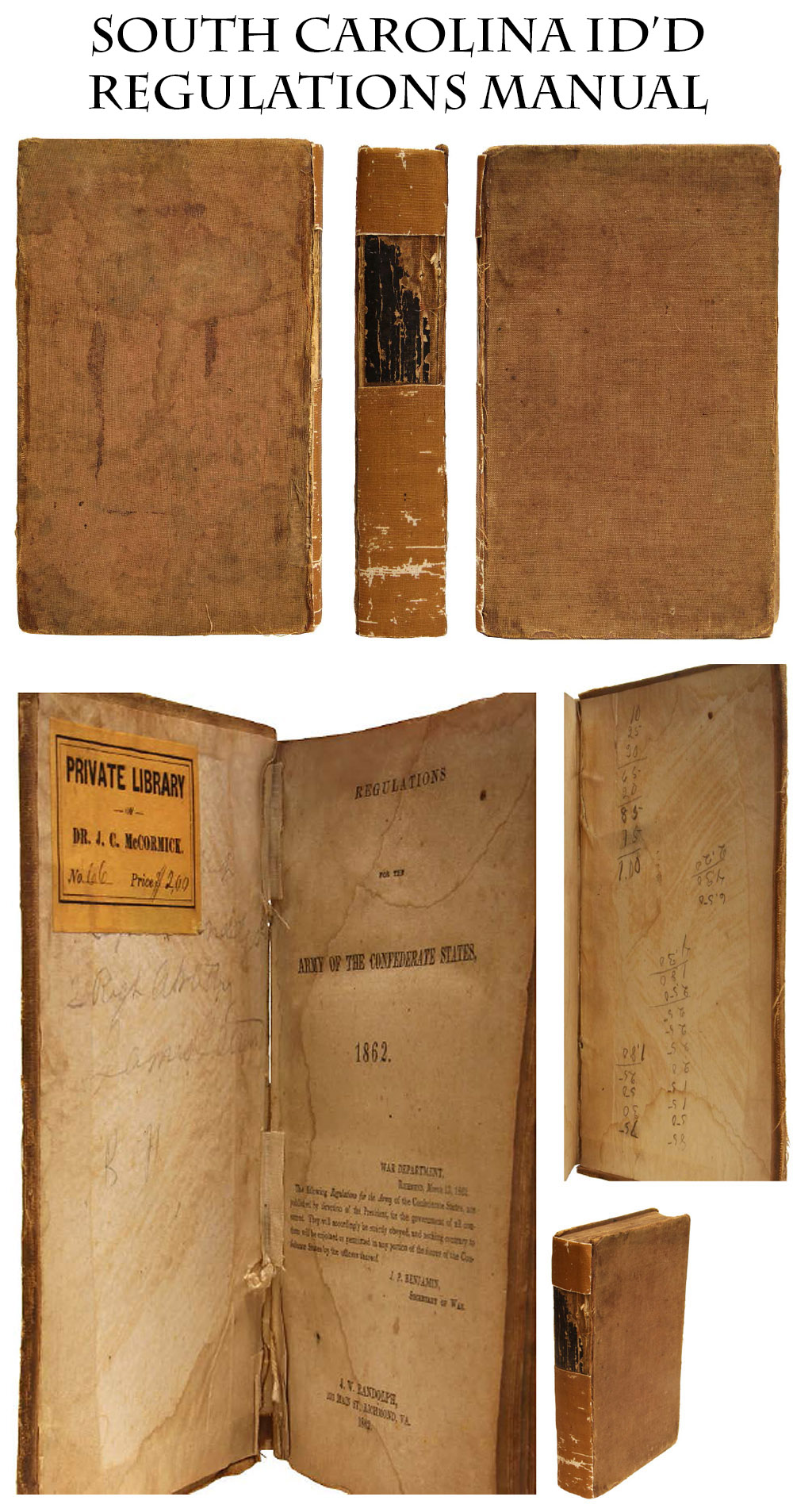
13-08-34 … James Island 2nd South Carolina Artillery – 1862 Regulations for the Army of the Confederate States,
published by Raymond in Richmond, Va, in 1862! Brown cloth over board binding, title panel on spine worn, (I had helper Tom add some original binding material to the spine for cosmetic purposes) … flyleaf missing. Orange label inside front cover: Private Library of Dr. J.C. McCormick No. 66 Price $2.00. Pencil markings below that are a most historic Confederate inscription partially obscured by the paper label, but discernable. We can see …edys Co. // 2nd Regiment Artillery … James Island This is likely William Kennedys Co H 2nd South Carolina Artillery. The manual itself came from the effects of Major J.K. Jackson CSA.
Any Confederate publication is rare. Resources were scarce and publishing books was not the top manufacturing priority, but creating a new army required structure and guidance. Here is a rare and solid piece of printed Confederate history with tangible history to James Island.
… $695.00
Click Here to E-mail Us!
Call us @ 419-842-1863

13-08-35 … Belgian import bayonet with correct U.S. scabbard.
These are sometimes called the Belgian 1842 pattern, but that is the US year designation for our .69 caliber percussion musket. The Belgian bayonets look similar but came with the large bore muskets we imported early in the war to outfit troops when we could not produce enough guns ourselves. This one has a correct US scabbard with an eight-rivet belt loop. Scabbard solid but with fold or crease mark about 2/3 down that had chipped the finish. Harness leather belt has worn and oxidized to brown giving a slight two-tone effect with the black bridle leather scabbard. Really quite handsome. Belgian maker and inspector marks on the bayonet. Locking ring functions. Smooth metal overall. Blade typically a tad light from being stored in the scabbard and the socket exposed to air.
Perfect to display with your musket or with early war infantry effects
… $275.00
Click Here to E-mail Us!
Call us @ 419-842-1863

13-08-36 … A REAL US Flintlock Musket: 1827 Dated Springfield 1816 Pattern in Original Flint.
Correct brass pan, reinforced hammer, sharp markings. VG+ condition with good stock edges and sharp legible marks: Springfield 1827 in three lines behind the hammer, eagle over US forward. Bands, springs, swivels all firmly in place. Ramrod is bent up and may be a period replacement. Small set of carved initial and a name opposite the lock near the cartouches. Smooth metal surfaces overall, with attractive plum brown patina. Just a couple minor dings in the wood. The initials and name are small enough they are hard to spot. The 1816 went through a number of minor pattern changes, enough to make it a collecting field in its own right. Frizzen spring screw should be tightened to change the angle of the spring, but it works fine and has probably been in that position for a hundred years or so.
Perfect for Alamo, or Mexican War or early Confederate display
… $1,650.00
Click Here to E-mail Us!
Call us @ 419-842-1863

13-08-37 – Confederate Leech & Ridgon Navy Cutlass:
I personally obtained this superb Confederate cutlass fresh out of a house in western Pennsylvania while on a buying trip with my youngest son Joe Johnston Taylor. Prior to our finding it, it was never on the collector market. Attic Fresh! (Actually not the attic, the family actually had it stored in a large wooden trunk in their parlor, along with some other antiques including the British saber bayonet described below.) What makes this weapon so wonderful is the presence of the original Confederate brass mounted leather scabbard. These scabbards are seldom found in any condition. This cutlass has the solid cast brass handle and ribbed brass guard. Nicely patinated steel blade. Quillon is severely bent (see photo). Drag on sheath is gone. Otherwise a superb specimen. Though all known specimens are unmarked, the cast grip and distinctive scabbard mount are unquestionably the product of Leech and Rigdon or Thomas Leech. 26.5 inches overall 21+ inch blade. Recently I owned and sold a rare unmarked Leech & Rigdon Bowie knife which incorporated the exact same handle and scabbard mount as seen on our cutlass. A very desirable Confederate edged weapon
… $4,250.00
Click Here to E-mail Us!
Call us @ 419-842-1863

13-08-38 – Model 1848 English Brunswick Bayonet Dated 1849.
From the same trunk as the above Confederate cutlass is this English bayonet. It has a very attractive age patina on the brass with pitting on the spring and button as shown in the photo. The 22 inch blade is stamped Enfield 1849 and on the reverse side some English proofs. B 65 is marked on the brass handle. Overall length of the bayonet is 27 inches. A scarce and desirable bayonet at a very reasonable price
… $275.00
Click Here to E-mail Us!
Call us @ 419-842-1863
Layaways are Welcome
Need to split your order into multiple payments? No problem! A simple 20% earnest money deposit will hold your item for you.-acf
You can then pay it off in easy installments that fit your budget.
Read Terms Here
Items to Sell? Contact Us
I am always interested in buying ANYTHING from the American Civil War… Guns, Swords, Civil War Muskets, Knives, Uniforms, Flags, Medals, Badges, Diaries, Letters, Autographs, Buttons, photographs, tintypes, daguerreotypes, Insignia, Camp Items, Battlefield Relics, canteens, Drums, Etc… Call 419-842-1863 and ask for Dave Taylor.

